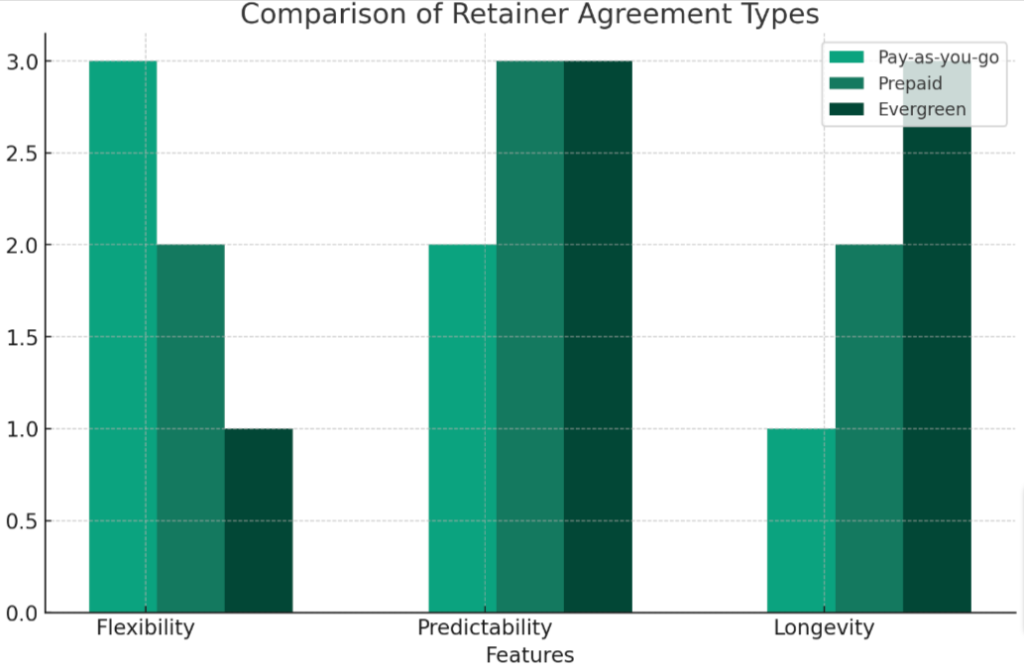Securing Stability: The Pros and Cons of Long-Term Writing Engagements
Are you wondering if retainer agreements and long-term contracts could be the right business strategy for you? Get this: nearly 65% of businesses use these methods to maintain steady income and secure services.
In this blog, we’ll guide you through everything from structuring a retainer agreement to weighing up the pros and cons of long-term contracts. Stay tuned – your next big financial decision could be easier than you think!
Key Takeaways
- Retainer agreements are legally binding contracts between a client and service provider that outline the terms of an ongoing working relationship.
- There are three types of retainer agreements: pay-as-you-go, prepaid, and evergreen. Each offers different benefits and considerations for both parties.
- Long – term contracts offer stability, steady income, and strong client relationships but may limit flexibility and require significant time commitment. Consider the pros and cons before entering into such an agreement.
Understanding Retainer Agreements
A retainer agreement is a contract between a client and a service provider that outlines the terms of an ongoing working relationship.
What is a retainer agreement?
A retainer agreement is a legally binding contract that outlines the terms of a business relationship between two parties. Typically formed between a client and a service provider, this contract requires the client to pay an upfront fee (known as ‘retainer fee’) for securing access to services or counsel over an agreed period of time.
The agreement spells out details like scope of work, payment terms, obligations, and how disputes might be resolved. Retainer agreements are common in the legal world but are also used by consultants, freelancers, and agencies in various industries who seek steady income while building strong long-term client relationships.

Purpose and types of retainer agreements
To fully understand retainer agreements, it’s helpful to explore the reasons they exist and the various forms they can take. Retainers provide a sense of stability for both parties involved, ensuring a dependable team for consistent work and offering predictable income for service providers.
- Pay-as-you-go retainers: Clients pay for services as they use them.
- Prepaid retainers: Clients pay upfront for a block of hours.
- Evergreen retainers: These contracts renew automatically until one party decides to end the agreement.
Advantages and disadvantages
Retainer agreements have their own set of advantages and disadvantages that both parties need to understand before signing.
| Advantages | Disadvantages |
|---|---|
| Provides a steady stream of income for the service provider. | Can limit the availability of the service provider for other potential clients, due to the time committed. |
| Ensures the client has dedicated assistance and services when they need it. | The client may end up paying for services they don’t use, if they don’t fully maximize the retainer agreement. |
| Facilitates long-term relationship between the client and the service provider, which can improve the quality of work. | Long-term commitment can be risky if the relationship between the client and service provider deteriorates. |
| Allows the service provider to better plan their workload and resources. | May require the client to pay even during periods when they don’t need any services. |
How to Structure a Retainer Agreement
To structure a retainer agreement, clearly define the scope of work and services provided, establish the retainer fee and payment terms, address intellectual property and confidentiality issues, outline dispute resolution procedures, and include provisions for termination.
Scope of work and services
The scope of work and services in a retainer agreement or long-term contract is a crucial component. It outlines the specific tasks, responsibilities, and deliverables that the service provider will undertake for the client over the agreed-upon duration of the contract.
This can include a detailed description of the services to be provided, timelines, milestones, expected outcomes, and any exclusions or limitations. Clearly defining the scope helps establish expectations and ensures both parties are on the same page.
It also allows for easy tracking of progress and provides a foundation for evaluating performance at regular intervals. By clearly defining what is included in the scope of work and services, you can set boundaries and avoid potential misunderstandings down the line.
Retainer fee and payment terms
Retainer fees and payment terms are essential aspects of a retainer agreement. The retainer fee refers to the upfront amount that a client pays to secure the services of an agency or professional.
This fee is usually paid on a monthly basis and provides stability for both parties involved. Payment terms outline how and when the remaining balance will be settled, ensuring transparency and avoiding any potential misunderstandings.
By clearly defining these terms, both the client and the service provider can establish a reliable working relationship built on trust, financial security, and mutual understanding.
Intellectual property and confidentiality
Protecting intellectual property and maintaining confidentiality are crucial aspects of any retainer agreement or long-term contract. By clearly outlining the terms related to intellectual property rights, such as ownership and usage, both parties can ensure that their interests are protected.
Confidentiality clauses help maintain trust between the client and service provider by preventing the disclosure of sensitive information to third parties. These provisions not only safeguard valuable assets but also promote a secure working relationship based on mutual respect and professionalism.
Dispute resolution
Resolving conflicts efficiently is crucial in any long-term relationship. When it comes to dispute resolution in retainer agreements or long-term contracts, having a clear process in place can save time and prevent unnecessary stress.
It’s important to include specific provisions regarding dispute resolution, such as mediation or arbitration, to avoid the need for costly legal action. By addressing potential disputes upfront and agreeing on a fair method for resolving them, both parties can maintain a positive working relationship and focus on achieving their shared goals without unnecessary disruptions.
Termination
Termination is a crucial aspect to consider when entering into any retainer or long-term contract. It’s important to establish clear guidelines and procedures for termination to protect both parties involved.
By outlining the circumstances under which termination can occur, such as breach of contract or failure to meet agreed-upon terms, it helps ensure accountability and allows for a smooth transition if necessary.
Termination clauses also provide an opportunity for either party to exit the agreement if it no longer meets their needs or goals. This ensures that both parties have the ability to review and adjust their commitments as needed, promoting transparency and flexibility in the working relationship without causing unnecessary strain or disruption.
The Pros and Cons of Long-Term Contracts
Long-term contracts offer benefits such as stable income and strong client relationships, but they also come with potential downfalls like being tied to a specific arrangement for an extended period of time.
Benefits of a long-term contract
Long-term contracts offer several benefits that can enhance opportunities for businesses and professionals. They provide a stable income and allow for better planning and resource allocation. With renewed contracts, both parties can build a strong client relationship and foster trust. Long-term contracts ensure a dependable team that is familiar with the client’s needs and can deliver high-quality work consistently.
They also provide security in terms of steady pay, allowing businesses to focus on long-term growth strategies rather than constantly searching for new clients.
Potential downfalls of a long-term contract
Long-term contracts may have some potential downsides to consider:
- It can limit your flexibility if your business needs change or if you want to explore new opportunities.
- You may become locked into a specific rate or pricing structure, which could prevent you from adjusting fees based on market changes.
- If the scope of work or requirements for the project change significantly, it can be challenging to renegotiate terms within the contract.
- Long – term contracts often require a significant commitment of time and resources, which might restrict your ability to take on other projects.
- The client’s needs and expectations may evolve over time, and it can be difficult to meet these changing demands without renegotiating the entire agreement.
Tips for Making the Most of Retainers and Long-Term Contracts
- Create clear and detailed monthly retainer contracts for both parties to review and adjust as necessary.
- Demonstrate the value of your services to clients consistently, showing them how working on a retainer basis enhances opportunities for their business.
- When pitching retainer services, focus on the benefits of long-term commitment and stability that come with working as part of a dependable team.
- Plan ahead by setting end dates or renewal points in advance, ensuring a smooth transition between contracts without any disruption in service.
Best practices for creating monthly retainer contracts
Creating monthly retainer contracts involves following certain best practices to ensure a successful and mutually beneficial arrangement. These practices include:
- Clearly define the scope of work and services to be provided each month.
- Establish a reasonable retainer fee and agree upon payment terms.
- Address intellectual property rights and maintain confidentiality throughout the contract.
- Include a dispute resolution clause to handle any potential conflicts.
- Specify the conditions for termination or renewal of the contract.
Proving value to clients
To prove value to clients, it is important to consistently deliver high-quality work that meets or exceeds their expectations. Communication plays a crucial role in demonstrating your value – keeping clients informed about progress, providing regular updates, and soliciting feedback shows that you are invested in their success.
Additionally, taking the time to understand your client’s business and industry allows you to provide tailored solutions and insights that add value. Building strong relationships based on trust and reliability will enhance opportunities for long-term contracts and retainers.
Ultimately, proving value means consistently delivering results while meeting your client’s needs and goals.
Pitching retainer services
Pitching retainer services to potential clients can be a game-changer for your business. By offering the convenience and stability of long-term contracts, you not only enhance opportunities for steady income but also establish strong client relationships.
When pitching retainer services, focus on the benefits such as having a dependable team that is committed to working hard and delivering smart, secure services. Highlight how retainers provide a steady pay and eliminate the need for constant contract renegotiations.
Emphasize the advantages of long-term commitment and how it allows both parties to plan ahead and achieve mutual success.
Planning for end dates
To ensure a smooth transition and maintain strong client relationships, it is important to plan for end dates when working with retainers or long-term contracts. By having a clear understanding of when the agreement will come to an end, you can effectively manage your workload and resources.
This allows you to review and adjust the terms of the contract if necessary, renew contracts with satisfied clients, or seek new opportunities if needed. Planning for end dates helps create stability in your income while also ensuring that both parties are aware of their commitments and obligations throughout the duration of the agreement.
Conclusion
So, are retainers and long-term contracts right for you? They can offer stability, a dependable team, and steady pay. However, there are risks involved in committing to long-term agreements.
Consider your goals and the nature of your work before making a decision.

